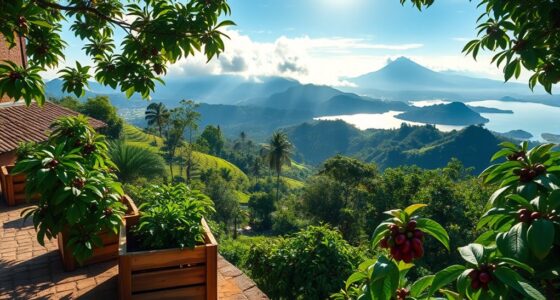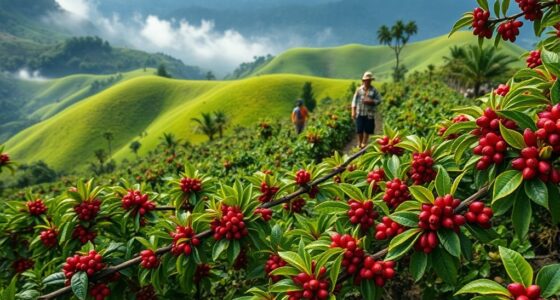Indonesian coffee offers a wide flavor spectrum, from Sumatra’s earthy, full-bodied profile to Java’s balanced, rich taste. Sumatra’s volcanic soil and lowland plantations create deep, smoky notes, while Java’s high-altitude farms produce brighter, nuanced flavors. Your brewing method can highlight different aspects of these beans, making each cup a unique experience. If you keep exploring, you’ll discover even more about how land, climate, and craft shape these remarkable coffees.
Key Takeaways
- Sumatra’s volcanic soil and lowland cultivation produce earthy, full-bodied coffees with bold, smoky flavors.
- Java’s higher altitudes and balanced climate yield smoother, rich brews with nuanced, aromatic profiles.
- Traditional and modern brewing methods enhance and highlight Indonesia’s diverse flavor characteristics.
- Regional land and climate conditions deeply influence the unique taste profiles of Sumatra and Java coffees.
- Experimenting with brewing techniques reveals the full complexity of Indonesian coffee’s land-inspired flavors.

Have you ever wondered what makes Indonesian coffee so unique? It all starts with the way coffee cultivation is shaped by the island’s rich volcanic soil, tropical climate, and diverse altitudes. These elements give Indonesian coffee beans their distinct flavors and aroma profiles. For example, Sumatra’s lush, lowland plantations produce beans with earthy, full-bodied characteristics, while highland regions like Java yield beans with a more balanced, rich taste. As you explore Indonesian coffee, you’ll notice that each region’s cultivation practices influence the beans’ quality, size, and flavor profile, making the journey of each cup a story of its land and climate.
Indonesian coffee’s unique flavors are shaped by volcanic soil, tropical climate, and diverse altitudes.
When it comes to brewing techniques, you have a wide array of options to bring out the best in these beans. Many connoisseurs prefer traditional methods like the pour-over or siphon brew, which highlight the beans’ complex flavors and aroma nuances. Others might enjoy a robust espresso or a slow French press to extract the deep, earthy qualities that define Indonesian coffee. The key is to understand that the brewing process can dramatically influence the final flavor. For instance, a longer extraction might amplify the bold, smoky notes characteristic of Sumatran coffee, while a shorter brew could emphasize the bright, nuanced flavors found in Javanese beans. Experimenting with grind size, water temperature, and brew time allows you to tailor each cup to your taste and discover how these variables *release* different aspects of the coffee’s personality.
Indonesian coffee also lends itself well to various brewing techniques because of its versatility. Whether you’re using a traditional cloth filter or a modern espresso machine, the goal remains to extract the richness and complexity stored within each bean. You’ll find that some brewing methods emphasize the earthy, herbal qualities, while others bring out the sweeter, more delicate notes. This flexibility means you can enjoy a traditional cup that pays homage to the country’s heritage or craft a contemporary brew that showcases its depth and complexity. Whatever your preferred style, understanding the fundamentals of coffee cultivation and experimenting with brewing techniques will deepen your appreciation for Indonesian coffee and enhance every sip.
In the end, what makes Indonesian coffee truly special is how it invites you to explore its diverse landscapes through every cup. From the earthy intensity of Sumatra to the rich, balanced brews of Java, each sip is a reflection of the land, climate, and careful cultivation behind it. By mastering different brewing techniques, you can *uncover* the full spectrum of flavors these beans offer, making each coffee experience uniquely yours.
Frequently Asked Questions
What Makes Sumatra Coffee’S Earthiness Unique?
You’ll notice Sumatra coffee’s earthiness stands out because of its unique soil composition and processing techniques. The volcanic soil provides rich minerals that give the brew its deep, earthy flavors. Additionally, traditional wet-hulling processing enhances this earthiness, producing a bold, full-bodied taste. This combination of natural environment and artisanal methods creates an authentic, robust coffee experience that’s distinctively Sumatra.
How Does Java’S Climate Influence Its Coffee Flavor?
Imagine walking through lush Java plantations, feeling the warm, humid air wrap around you. Java’s climate impact, with its consistent rainfall and mild temperatures, creates ideal terroir variations that shape its coffee’s rich, full-bodied flavor. The steady warmth enhances sweetness and adds a hint of spice, making each brew smooth and well-balanced. Your palate senses the harmony of climate and soil, crafting a coffee experience that’s uniquely Java’s own.
Are There Specific Brewing Methods for Indonesian Coffee?
You might wonder if Indonesian coffee needs special brewing methods. While traditional methods work well, you can bring out unique flavors with cold brew or AeroPress techniques. Cold brew smooths out the earthiness, highlighting the coffee’s richness. AeroPress allows quick extraction of complex notes, perfect for showcasing Indonesian beans. Experiment with these methods to enjoy Indonesian coffee’s distinctive profile, whether it’s Sumatra’s deep earthiness or Java’s bold richness.
Which Indonesian Coffee Regions Are Best for Beginners?
If you’re new to Indonesian coffee, start with Java or Bali regions, as their coffee varieties tend to be smoother and more approachable. These regions use traditional harvesting techniques that preserve the beans’ quality, making brewing easier for beginners. You’ll enjoy balanced flavors and consistent profiles, perfect for learning brewing methods. As you explore, you’ll appreciate how regional differences influence taste, helping you find your favorite Indonesian coffee.
How Sustainable Is Indonesian Coffee Production?
You might wonder how sustainable Indonesian coffee production is. It’s quite diverse; many farms pursue organic certification and implement fair trade practices, helping safeguard the environment and ensure fair wages. However, challenges like deforestation and climate change impact some regions. By choosing certified organic and fair trade Indonesian coffees, you support sustainable farming, contributing to healthier ecosystems and better livelihoods for local farmers.
Conclusion
As you sip this coffee, let each cup be a mirror of Indonesia’s soul—its earthiness echoing Sumatra’s rugged landscape, and its richness reflecting Java’s vibrant spirit. Feel the warmth seep in, connecting you to a land where nature’s bounty is brewed into every drop. Remember, each taste is a journey through centuries of tradition, a symbol of resilience and passion. With every sip, you carry a piece of Indonesia’s heart—timeless, bold, and waiting to be discovered.









